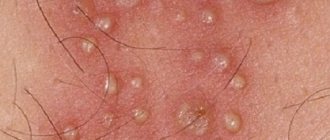Kinds
Herpesviruses of the Herpesviridae family that infect humans:
- Alpha herpes viruses are the most common types: HSV-1 (oral herpes), HSV-2 (genital herpes), and chickenpox. A distinctive feature of the group is the rapid destruction of infected cells.
- Betaherpesviruses are the most pathogenic infectious agents of herpes type 6, type 7 and cytomegalovirus. They cause less pronounced degenerative changes in cells,
- Gammaherpesviruses are herpes type 8 and Epstein-Barr virus. They are capable of infecting the systems of mononuclear macrophages (immune cells), causing processes of cell death.
The virus cannot be removed from the host cells; it remains in the body for life. Treatment is aimed at reducing the manifestations of symptoms, concomitant diseases, and making the patient’s life easier. A vaccine is being developed.
Cytomegalovirus
This type of virus causes cytomegalovirus infection (CMVI, cytomegaly). It has a large DNA genome and relatively low pathogenicity. Develops without damaging the cell. The new viral particles that are formed already inside the body infect macrophages, epithelia, and myeloid cells. In them, the virus enters the latent phase. It is believed that due to cytomegaly, pathological inflammatory processes begin to develop in humans with age.
The source of infection is an infected person. Cytomegalovirus is transmitted by airborne droplets and through all existing fluids: genital secretions, blood, saliva, breast milk.
The virus, slowly spreading throughout the body, provokes changes in infected cells with an increase in size. In healthy people, cytomegaly is mild or asymptomatic. It is particularly dangerous for persons with pathologies of the immune system, young children and pregnant women due to the risk of infection of the fetus. In immunocompromised patients, CMV infection is one of the causes of illness and death.
Acquired cytomegaly has symptoms similar to seasonal colds. Congenital (intrauterine), can cause miscarriage and lead to fetal pathology. In children under 3 months and in adults with pathologies of the immune system or oncology, cytomegalovirus infection can be severe. Complications include lung damage, viral encephalitis, changes in the liver, kidneys, and gastrointestinal tract.
Epstein–Barr virus (EBV)
Belongs to group 4 of herpesvirus (Herpesviridae). Looks like a double-stranded DNA molecule. It is not integrated into the cellular genome of the infected cell, but resides in the nucleus. There are two types of Epstein-Barr virus: EBV-1 and EBV-2. They are equally common and have similar symptoms. They differ in their transformation abilities and latent flow characteristics. The virus replicates in lymphocytes and epithelium and does not cause destruction.
The source of infection is an infected person with a manifest and latent form. The infection is spread by airborne droplets.
The disease with strong immunity almost always occurs without symptoms. In immunocompromised patients, it manifests itself as infectious mononucleosis. In the manifest (active) form of EBV infection, the level of CEC increases, and the activity of leukocytes, on the contrary, decreases. This may lead to adverse immunopathological reactions.
In case of immunodeficiency, the Epstein-Barr virus can provoke the development of lymphoproliferative disorders and trigger oncology. In people with autoimmune diseases, it affects overall well-being, causing chronic fatigue syndrome.
Infectious mononucleosis
Acute disease caused by the Epstein–Barr virus. It develops against a background of weakened immunity, mainly in children and adults under the age of 40. It can occur in mild, moderate and severe forms.
Common symptoms include fever, oral lesions, and lymphadenopathy. Less commonly, significant enlargement of the spleen, leading to rupture. An atypical form of mononucleosis can also cause acute multiple organ failure, myocarditis, and meningitis.
The visceral form of the disease is characterized by serious multiple organ lesions. Pathological processes involve the central and peripheral nervous systems, organs of the cardiovascular system, kidneys, adrenal glands and other vital organs.
Herpes virus type 6 (HHV-6)
The virus mainly replicates in T lymphocytes, but sometimes it is detected in B lymphocytes, the mononuclear macrophage system, hepatocytes and other cells. The source is an infected person. The herpes virus is transmitted by airborne droplets and directly to the child from the mother.
The list of diseases caused by HHV-6 is quite wide. More often, pathologies occur in people with a suppressed immune system. In other cases there are no symptoms.
In newborns, due to infection, exanthems occur, the first fever in life. In adults and older children, the disease occurs as mononucleosis. HHV-6 carriers have an increased risk of developing malignant lymphoma, histiocytic lymphadenitis, T-cell leukemia and B-cell lymphoma. In immunocompromised individuals, infection is more severe. In some cases it leads to pneumonia, hepatitis, and encephalitis.
Herpes virus type 7
HHV-7 is usually found together with HHV-6. They differ slightly from each other - in body weight and the number of base pairs. Herpes virus type 7 is primarily localized to CD4+ T cells. It suppresses CD4, and also affects syncytium, causes unprogrammed cell death, and changes the level of cytokines.
The specific effects of HHV type 7 separately from HHV-6 have not yet been sufficiently studied. However, it is known that this type affects CD4, like HIV infection, and therefore has a negative impact on the course of winter diseases. Capable of maintaining the existence of latent infections.
Herpes virus type 8
The HHV-8 virus, Kaposi's sarcoma herpesvirus (KSHV), stimulates the synthesis of lymphoid, dendritic, epithelial cells and secretion of the prostate epithelium. The presence of HHV-8 in the body increases the risk of developing tumor diseases.
The main methods of infection: sexual, hematogenous (blood transfusion), horizontal (with saliva), transplacental (the fetus becomes infected during pregnancy). The largest number of copies of the virus is found in saliva.
Herpes virus type 8 can stimulate the occurrence of neoplasms:
- Kaposi's sarcoma;
- lymphoma;
- multiple myeloma;
- Castleman's disease.
Pathologies occur due to aging, immunodeficiency and HIV infection. Almost half of people infected with HPV-8 develop Kaposi's sarcoma within 10 years of infection. All HIV-infected patients with Kaposi's sarcoma are diagnosed with herpes virus type 8.
Survival rate is 72% with early diagnosis and therapeutic procedures. However, HHV-8 is more difficult to treat than other types. At the moment, no sufficiently effective medications have been developed.
Herpes simplex type 1
The herpes simplex virus combines the first and second serotypes of the herpes virus. Herpes simplex virus type 1 is designated as HSV-1 or HSV-1 (Herpes simplex virus 1). In the clinical literature, it is also called oral (oral) or labial (lip) herpes.
HSV-1 is the most common type of herpes of all those with clinical significance for medicine. Infection usually occurs in the first years of a person's life. The most typical localization of oral or labial herpes is the lips and nasolabial triangle.
Under certain circumstances (immunodeficiency), the virus can also infect:
- The mucous membrane of the genital organs, mouth, nasal cavity and eyes;
- The skin of the fingers and toes (most often the area of the nail fold of the fingers);
- Tissues of the nervous system.
Herpes simplex viruses types 1 and 2 are characterized by:
- Neurotropism is the predominant damage to cells of the nervous system due to the presence or formation of receptors in them that are complementary to viruses;
- Neurovirulence is the ability to cause diseases of the nervous system;
- Suppression of phagocytosis (immune link) to an incomplete level.
Tropism for nervous tissue and the ability of HSV to inhibit phagocytosis are factors indicating the ability of herpes simplex viruses to avoid the effects of the immune system, which makes latent carriage in nervous tissue possible. Persistence in the cells of the nervous system is an important protective and adaptive mechanism of herpes viruses, which allowed HSV-1 to become as widespread as possible in the human population.
Simple type viruses are characterized by two phases of being in the body - latent and manifestation:
- Clinical manifestation of HSV occurs 1-3 times a year, pathogenesis on the lips develops and ends within seven to ten days. The frequency of relapses depends on the person’s immune status; people with immunodeficiency conditions get sick more often;
- The latent (hidden) phase, invisible to the immune system, lasts for the rest of the life of the virus.
Symptoms of herpes type 1
The most common clinical form of HSV-1 in children is vesicular lesions of the lips, sometimes acute respiratory disease. In adults, lesions of the skin, conjunctiva and cornea of the eyes are also observed. With oral-genital contact, HSV-1 manifests itself as damage to the genital organs. Women are infected with the genital form of HSV-1 much more often than men.
The general clinical sign of HSV-1 is intoxication syndrome:
- Fever;
- General weakness;
- Headache;
- Muscle and joint pain.
igg (IgG) positive
For the differential diagnosis of HSV-1 and HSV-2, laboratory methods are used, the purpose of their use is to:
- Determining the type of pathogen based on affinity with the corresponding immunoglobulin;
- Differentiation of the pathogen, for example, HSV-1 from HSV-2;
- Determining the stage of the disease (acute, chronic, latent).
Approximate interpretation of study results when identifying immunoglobulins IgM and IgG:
- IgM is determined by laboratory methods starting from the fifth day of the disease, and IgG is determined only from the second week from the onset of the disease;
- IgM circulates in the peripheral blood for up to three months, and IgG is present in the blood for many years, and in the chronic course of the disease - for life;
- IgM does not penetrate the placenta during pregnancy, but IgG penetrates the placenta in large quantities, that is, detecting it in a pregnant woman who does not have clinical manifestations of herpes means the body is ready to protect itself in case of accidental infection during pregnancy;
- IgM is not able to neutralize the virus and is only a factor in triggering immune processes in the body, while IgG is able to neutralize the virus, therefore it is a factor in the body’s defense.
Detection of IgG specific for HSV-1 in peripheral blood in high titers during the clinical course of the disease using the PCR technique indicates the development of intense immunity to this disease.
Detection of IgG in low titers with a negative PCR reaction indicates a previous illness and that the herpes virus is in a latent state in the body.
Herpes simplex type 1 during pregnancy
Women in general are more susceptible to the herpes simplex virus. It has been proven that the herpes clinic is provoked by conditions that weaken the body’s immune system. Pregnancy and its manifestations (intoxication, hormonal changes) are certainly factors that disrupt homeostasis. Herpes during pregnancy in the form of a clinical manifestation can occur with a high degree of probability.
Herpes simplex virus type 1 is very dangerous for pregnant women because:
- In the normal state of the body, it does not affect the genital organs, meanwhile, during pregnancy, the development of pathogenesis can result in damage to the nervous tissues of the fetus (the virus penetrates the placental barrier);
- During pregnancy, HSV-1 is extremely undesirable, especially during the initial development of clinical manifestations against the background of the absence of protective antibodies (specific immunoglobulins) in the blood, which are formed in response to illness. Moreover, antibodies to HSV-1 do not protect a pregnant woman from HSV-2 (genital form of herpes);
- The herpes simplex virus entering the body in the first half of pregnancy can cause deformities in the fetus;
- HSV-1 or HSV-2, which enters the body of a pregnant woman in late gestation, can cause infection of the fetus during childbirth.
Treatment of herpes type 1
Treatment of viruses of this group has important features:
- Total destruction of the virus is impossible;
- There are no preventive medications;
- Viruses are not sensitive to antibiotics;
- With a short-term course of HSV-1, drug treatment is not advisable.
The only direct acting drug is acyclovir. The pharmaceutical industry produces acyclovir in three formulations (tablets, ointment and solution).
The use of acyclovir in accordance with the instructions can significantly reduce:
- Duration of the clinical course of the disease;
- Frequency of relapses of the disease in clinical form.
Symptoms
As a rule, symptoms appear only in young children or in adults with a pathology of the immune system, HIV-infected people taking medications that suppress the immune system. It can occur after serious illnesses, transplantation and other surgical interventions. Symptoms are quite extensive, but are more often expressed in fever and rash on the skin and mucous membranes.
Cytomegalovirus infection
- In the acquired form, the following is observed:
- Temperature increase.
- General malaise, weakness.
- Headache.
- Enlarged neck lymph nodes, sore throat.
Rarely, complications occur in the form of pneumonia, arthritis, and symptoms of hepatitis.
Congenital is expressed in the following symptoms:
- Hepatosplenomegaly is an enlargement of the spleen and liver.
- Microcephaly is a significant reduction in the size of the skull and, accordingly, the brain.
- Jaundice of the skin and sclera.
- Petechiae is a hemorrhagic rash that occurs due to damage to intradermal capillaries.
- Neurological abnormalities.
Infection with cytomegalovirus during pregnancy can lead to the death of the embryo and pathological damage to the fetus. These include hemorrhagic syndrome and damage to the nervous system. Sensorineural hearing loss and balance disorders are more common, and intellectual disorders, epilepsy, cerebral palsy, visual impairment, and microcephaly are less common.
Epstein–Barr virus
Primary infection is characterized by:
- Catarrhal sore throat.
- Nasal congestion.
- Enlarged lymph nodes.
- Moderate increase in lymphocytes.
Manifest form - infectious mononucleosis is accompanied by:
- fever;
- general malaise;
- headache;
- sore throat;
- enlarged cervical lymph nodes, pain;
- splenomegaly;
- hepatomegaly;
- jaundice.
Infectious mononucleosis:
- Heat.
- Headache.
- Inflammation of the pharynx and tonsils.
- Enlarged and painful lymph nodes.
- Enlarged liver and spleen.
In severe forms of the disease, complications may occur in the form of otitis media, sinusitis, hepatitis, peritonsillar abscess, and pneumonia.
Herpes virus HHV-6
It has a wide range of symptoms, with the following symptoms most often noted:
- temperature up to +40 °C;
- symptoms of intoxication;
- erythematous or papular rash;
- mild hyperemia of the pharynx.
If a person has a strong immune system, without pathologies, then HCH-6 is asymptomatic.
Herpes virus HHV-7
No symptoms identified. In persons with immunodeficiency, it can cause pseudorubella, fever, pityriasis rosea, convulsions, and chronic fatigue syndrome.
Herpes virus HHV-8 (HHV-8, Kaposi's sarcoma)
Clinical manifestations are observed only with immunosuppression. They are expressed in the appearance of vascular seals and form on the skin and in the mouth. These are multiple hemorrhagic neoplasms of a malignant nature. Over time, the virus can cause complications in the lungs, gall bladder, bile ducts and other internal organs.
Forms of manifestation of the herpes virus
The presence of the herpes virus in the body does not manifest itself in any way in a healthy person. It begins to appear only when the immune system is suppressed. This can happen due to hypothermia, alcohol abuse, smoking, sudden stress, skin trauma in the perioral area (around the mouth), overwork or lack of sleep.
Most often, herpes on the lips manifests itself as a fine blistered rash in the mouth area. After a few days, the contents of the bubbles become cloudy. If the formation is not disturbed, the bubbles dry out, they become covered with a crust, which disappears on its own after a few days. But if the bladder has been damaged, an ulcer will form in its place. You may also feel a tingling, burning sensation of the skin in the damaged area and swelling.
Diagnostics
Diagnosis of infections caused by herpes viruses is based on laboratory tests. They use polymerase chain reaction methods performed in real time.
PCR is the most accurate way to detect all types of herpes. It is also one of the fastest in production and allows identifying the pathogen at an early stage of the disease. To obtain the result, a small amount of the desired material is sufficient.
A special feature of the PRC method is the copying of a DNA region specific to the pathogen. It is reproduced a number of times that enlarges the sample to a size acceptable for diagnosis.
Any biological material is suitable as a sample:
- deoxygenated blood;
- seminal fluid;
- vaginal discharge;
- saliva;
- cerebrospinal fluid;
- biopsy and others.
Other methods for diagnosing herpes include molecular biological studies of skin biopsies for the diagnosis of Kaposi's Sarcoma. Hair follicles are examined to confirm or rule out HHV-6. The digital droplet PCR method helps to identify chromosomally integrated and inherited forms of type 6 virus. For tissue-invasive CMV, preference is given to histological and immunohistochemical studies.
When is a test for herpes viruses prescribed?
- In the presence of symptoms indicating diseases caused by herpes viruses.
- To differentiate herpesvirus and other infections.
- When planning pregnancy and in the presence of pregnancy pathology.
- For a comprehensive examination of HIV patients and people with immunodeficiency.
- Before immunosuppressive therapy.
- To monitor the effectiveness of therapeutic measures.
It is necessary to undergo a herpes test for patients with hematological malignancies and lymphoproliferative diseases. A study before and after transplantation is indicated.
Herpes type 7
Herpes virus type 7 is referred to as HHV-7 or HHV-7. Often this type of virus is combined with herpes virus type six. HCH-7 is a possible cause of chronic fatigue syndrome and cancer of lymphoid tissue.
Symptoms of herpes type 7
The following main symptoms of herpes type 7 are distinguished:
- Weakness due to lack of physical stress, increased nervousness;
- Light physical activity is accompanied by rapid fatigue;
- Excessive increase in suspiciousness;
- Chronic depressive conditions;
- Sleep disorders (insomnia);
- Long-term (up to 6 months in a row) subfebrile body temperature;
- Enlarged lymph nodes.
Anamnesis and physical examination methods are complemented by laboratory tests:
- Polymerase chain reaction (PCR) - detection of the genetic material of the virus,
- Enzyme-linked immunosorbent assay (ELISA) – determination of IgG titers;
- Immunogram with determination of subpopulations of T- and B-lymphocytes (decrease in the content of natural killer cells and increase in circulating immune complexes).
Treatment of herpes virus type 7 consists of antiviral therapy aimed at strengthening the immune system. Preventive measures have not been developed.
Treatment
Since the herpes virus is integrated into the genome of a human cell, it cannot be removed. Therapeutic measures are aimed at diseases caused by herpes viruses. For treatment, etiotropic drugs and means to relieve symptoms are prescribed. The choice of medications, dosage and method of treatment are chosen individually, based on the patient’s condition, the presence of complications and concomitant diseases.
Herpes viruses are activated against a background of suppressed immunity; most patients are HIV-infected. In this case, treatment is indicated in immunologically favorable conditions, in which case the risk of complications is lower and the chances of cure are higher. However, patients with a poor prognosis also undergo individual, not always systematic, treatment.
Causes of herpes
The causative agent of the disease is a group of viruses that infect the skin, nerve cells, and mucous membranes of humans. Rashes appear on the body in the form of a group of blisters, which dry out and disappear after using medications.
Herpetic infection is the most common among the adult population. The virus affects more than 90% of people, 10-20% of whom have an acute form of herpes. Once pathogens enter the human body, they accumulate and manifest themselves in weakened immunity. Pathological rashes appear on the body in periods, most often in the same place.
Herpes is transmitted in several ways:
- contact – physical contact with an infected person;
- airborne - through saliva particles when sneezing and coughing;
- sexually – genital herpes is most often transmitted this way. During unprotected sexual intercourse;
- household - through shared items (towels, dishes, bed linen);
- vertical - from a pregnant woman to a child during pregnancy or childbirth.
Once in the human body, the herpes virus spreads through the bloodstream. It penetrates the nerve cells of the peripheral nervous system and is integrated into the genome of neurons. From this moment on, the virus accompanies a person throughout his life.









